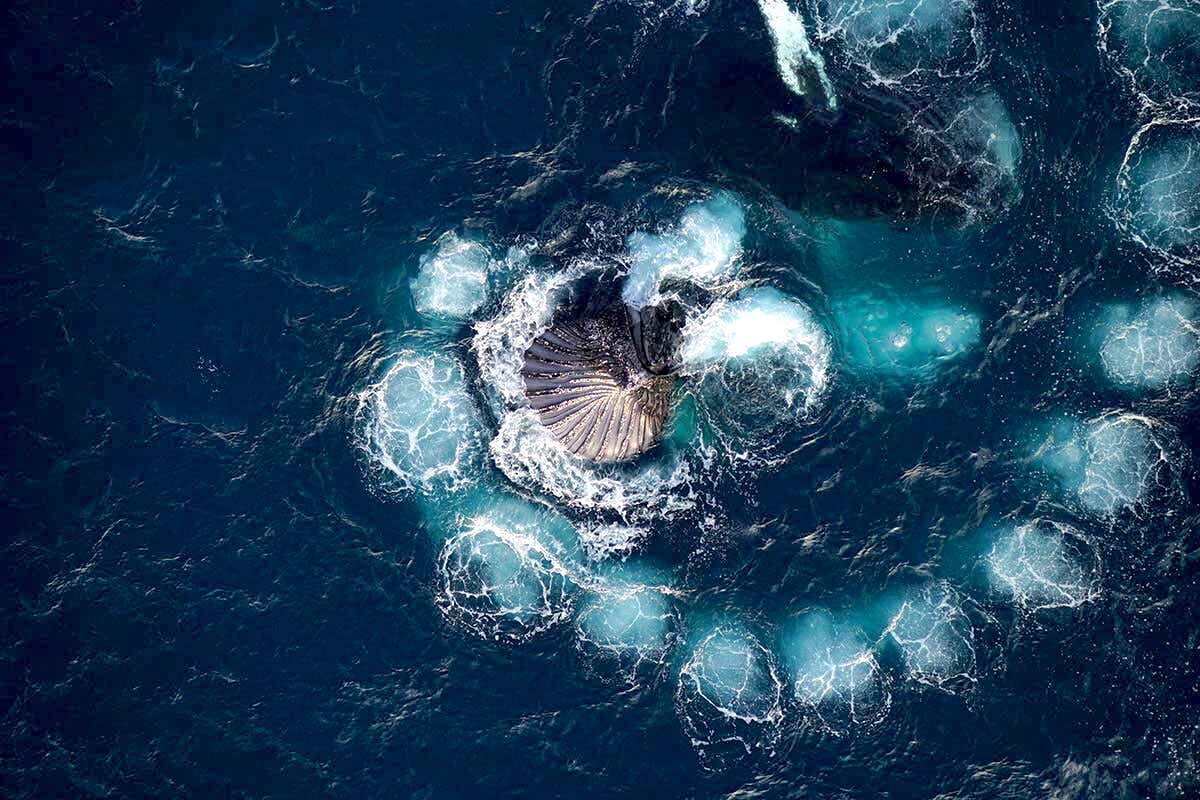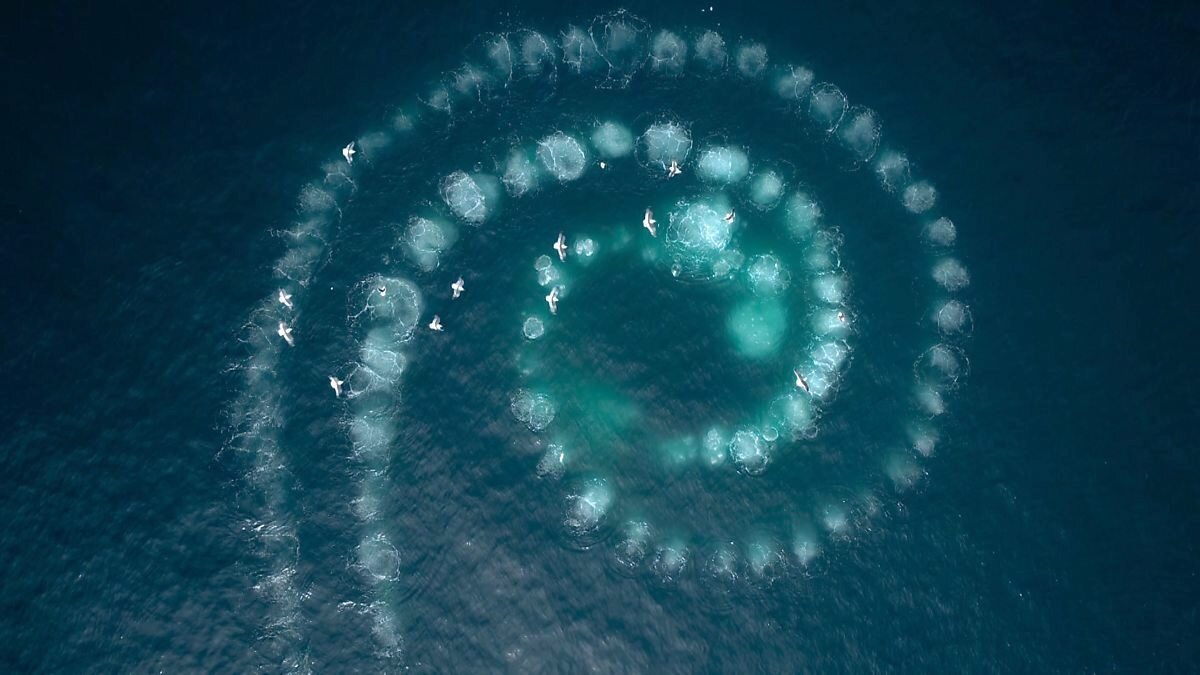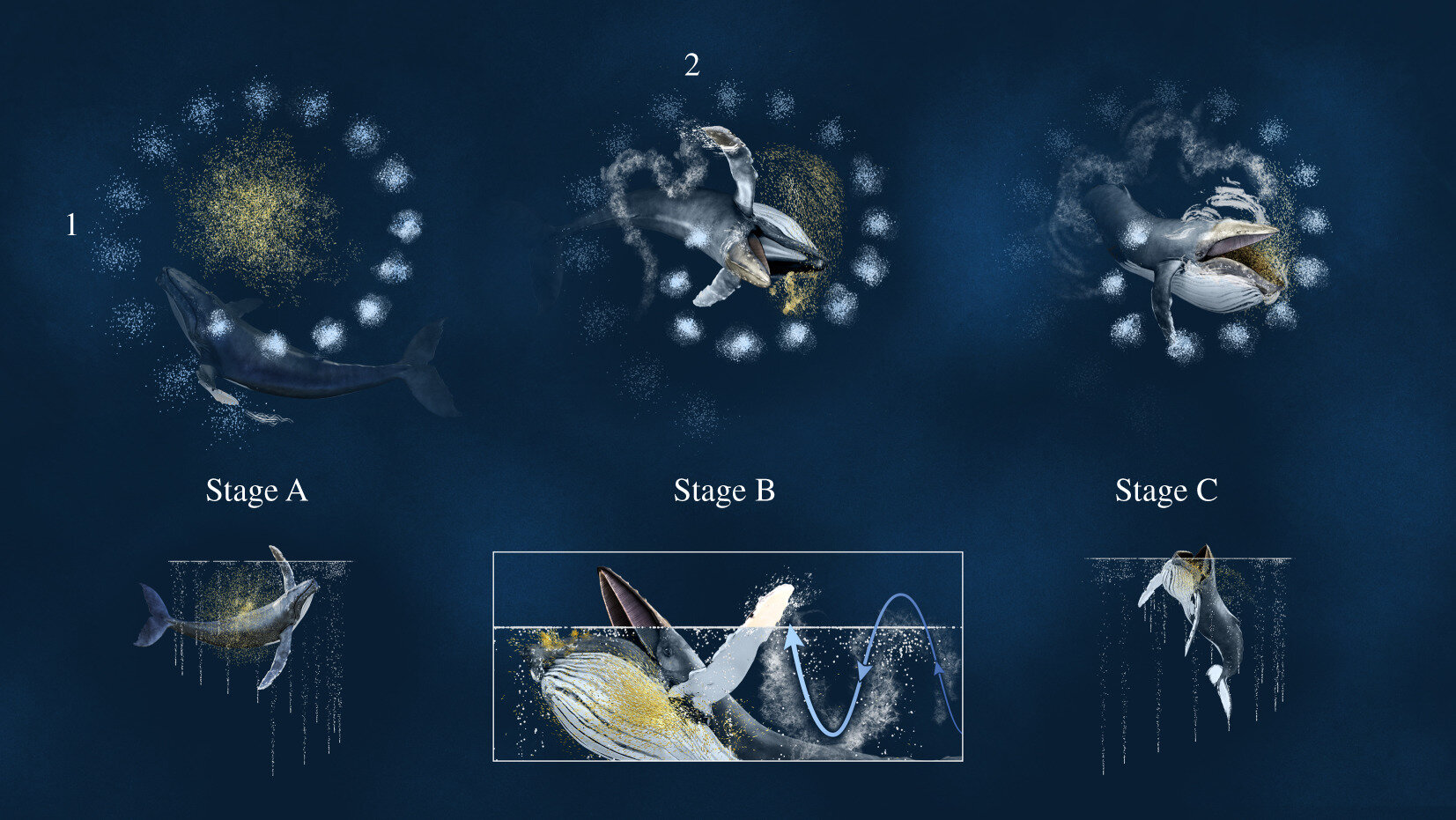1974 | Shelter Island, Alaska
Humpback whale (Megaptera novaeangliae) bubble netting
Animals do interesting things. And they don’t always wait until a notebook-wielding scientist is nearby to do them. Which means that amateur enthusiasts have always played a vital part in driving our understanding of animal behaviour. From early naturalists to modern crowd science (have you tried zooniverse yet?), what we know often depends on who takes the time to look.
Today we dive into a case of animal tool use that you might think would be obvious to everyone—after all, it involves perhaps the largest tool-using animal on the planet. But as we’ll see, everything from its location to its definition can be problematic for researchers. Oh, and it’s inspiring cutting-edge work in machine learning and computer science. Welcome to the bubbly, three-dimensional world of the humpback whale.
Jurasz-ic Park
Around a dozen kilometres west of the airport for Juneau, Alaska, you’ll find Shelter Island. It’s small, part of the chain of inlets, fjords and isolated pieces of land that eventually stretches down south to Vancouver Island. A little further west is Glacier Bay, since 1925 a US National Monument and later National Park, thanks in part to the writings of pioneer American conservationist John Muir.
Here’s a humpback breaching (propelling its body out of the water) in Glacier Bay:
In the summer of 1974, local high school teacher Charles Jurasz was out on the water with his wife Virginia and their children, in their 50-foot wooden boat Ginjur. They were hunting whales, and had been doing so every summer since the mid-1960s. They weren’t hunting for flesh, or oil—even though commercial whaling was still legal at the time—instead they were counting humpback whales as they fed in the region, and tracking the effect of local boats on whale behaviour.
To keep track of individual whales, the Jurasz family came up with the novel idea of photographing the tails of each animal as they dived beneath the surface. A humpback tail spreads out into two flukes, each of which has a distinctive pattern of notches and splotches. Nowadays the use of fluke identification is commonplace for whale researchers around the world, but fifty years ago it was just something the Jurasz’s thought up to help them keep track of the returning cetaceans.
Here’s an example. In the left image below is a photo taken by Charles Jurasz in August 1978, south of Juneau in Frederick Sound. On the right is the same whale (now known as NMMLID 229) a little further north and 28 years later, in a photo taken in December 2006 by Dan Salden of of the Hawai’i Whale Research Foundation. Note the matching white pattern on the underside of the flukes:
So it was that on 13 July 1974 the family found themselves off Shelter Island. Just after midday, they noticed two adult humpbacks coordinating their dives. The animals would head underwater together, and a few seconds later a series of bubbles started to appear on the surface. The bubbles formed into a circle around 30m across, and took almost a minute from first to last appearance.
As the bubbles spread they enclosed an ever tighter circle, and just as the last bubbles rose so did the whales. They emerged together, each lunging sideways with their huge jaws agape. At the same time, the surface of the water began to boil with herring, trapped by and trying to flee the bubble circle. With nowhere to go, the tiny fish flipped and flopped straight into the waiting humpback mouths.
The Jurasz family watched for over five hours as the whales repeated the trick another 24 times. Each time they would swallow a huge mouthful of herring, wait several minutes and then start the next bubble circle, usually less than 100m from the last one. As they fed, the whales were heard singing.
Naturally enough, Charles and Virginia termed this behaviour ‘bubblenet feeding’ when they published a paper on it in 1979. Their wider observations, funded by the US National Parks Service from 1976 to 1981, were critical for driving further research into humpback behaviour around Glacier Bay, including the effects of local tourism and fishing. However, despite spending tens of thousands of hours diligently finding and recording whales, as amateurs they did not have training in report writing or statistical analysis, and as a result they were not always given the respect or trust they deserved by established researchers and administrators.
The Jurasz’s were not the first to notice this particular humpback feeding pattern—a report from 1929 by Norwegian whaler Andreas Ingebrigtsen described the same use of a circular wall of air by Alaskan humpbacks. However, in the intervening years recording the feeding habits of these animals was typically far behind concerns with slaughtering them. For instance, Ingebrigtsen’s father, Morten Andreas Ingebrigtsen, was a prolific whaler, introducing the idea of hauling a harpooned whale onboard a ship for processing, and killing whales from Norway to the Mexican and West African coasts.
By the time the Jurasz family began their amateur catalogue in the mid-1960s, there were only around 1,000 humpback whales in the entire North Pacific Ocean, perhaps 5% of the pre-whaling population. The International Whaling Commission banned North Pacific humpback whaling in 1966, and established a moratorium (technically a pause in activity), on all commercial whaling from the 1985/1986 season onwards.
On an upwards spiral
We now know that bubble nets aren’t solely an Alaskan phenomenon. For one thing, humpback whales have famously long annual migrations: the ones seen around Glacier Bay in summer mostly spend their winters in Hawaii, or in a few cases off the coast of Mexico. Bubble-net feeding has now been seen off the coasts of Canada and eastern USA, as well as around the Antarctic Peninsula. And in September 2020 there were the first documented reports of humpback bubble nets off the east coast of Australia.
In each of these areas the behaviour is quite similar. So what does it involve, exactly? And how does it help the whales get more bang for their bite?
Let’s start by looking at it from the whale’s perspective, literally. Here’s a 2 minute video from the Marine Mammal Research Program at the University of Hawai’i and the Alaska Whale Foundation, using drones and whale-mounted cameras to document the whole process:
You’ll see that after an initial dive to around 20-25m depth, the whale turns in a tightening spiral, emitting spurts of air from its blowhole like an old-fashioned steam train. As the bubbles rise, they form a moving wall that surrounds and corrals any prey caught in the centre. The final step is for the whale to drive straight up the middle, finishing with a massive lunge either just under the water, or out and then across the dissipating bubble net.
A second variation was recorded by David Wiley and his team from NOAA. In what they termed ‘double-loop’ feeding, the first deep circle produced an initial bubble net, then the whale headed to the surface to slap the water with its tail. Finally, a second, shallower bubble loop set the scene for the feeding lunge. The tail slap, or ‘lobtail’ behaviour, may help to concentrate prey by alarming them and causing them to swim more closely together.
These images from Wiley’s work show a typical upward spiral path and the double-loop variation, as recorded by tracking devices stuck (safely) to the whales:
Lobtail feeding seems to be a cultural innovation among humpbacks, starting in 1980 with one whale in the Gulf of Maine. Jenny Allen and her colleagues then tracked the spread of this activity over 27 years (and almost 74,000 whale sightings), by which point more than a third of the whales in the region used the lobtail technique. Allen found that the most likely explanation was that the whales learned this technique from each other—and not from their mothers, with whom young whales initially spend their time. The ability to spread new behaviour specific to one group is very common among humans, ranging from what we wear to how we speak, but we certainly don’t have a monopoly on culture.
Just as impressive is when multiple humpbacks build a net together, as the Jurasz family saw back in 1974. From a bird’s eye view, the coordination is clear, as the two animals zero in on their food. This image is from the BBC’s Seven Worlds, One Planet series (see the Antarctic video at the end of this post too), and it also shows that the significance of the bubble net is not lost on actual birds, who gather as the net forms to get their share of the spoils:
It’s a remarkable use of air as a tool, air being one of the few tools available to an ocean-dwelling mammal that lacks hands. It’s even debatable as to whether this should be considered tool use at all. But the skill and timing with which the whales construct their nets, and their clear purpose, argues that this should sit alongside other mobile technologies that trap or contain their target.
And did I say whales don’t have hands? Of course they do, sort of. The humpback even gets it’s scientific name—Megaptera, Greek for ‘giant wing’—from its long pectoral fins. Those fins come in handy for making the tight turns needed to build a bubble net, and scientists have also found that these crafty cetaceans can use them to add an extra wall inside their net. After a whale releases its spiral, Madison Kosma and her Alaskan team saw instances of a humpback waving its fin up and down as it completes the circle, just before the final lunge. They termed it ‘pectoral herding’.
Of course, having a massive paddle also comes in handy for just shovelling more fish into your mouth, and Kosma found whales doing that too. Here’s a handy visual guide to the three stages of pectoral herding:
Also, remember how the Jurasz’s reported the whales singing as they worked? That may not have been idle chatter. There’s some evidence that channelling whale-song through the bubble net works to increase its effectiveness.
The idea was first proposed back in 2004 by Timothy Leighton, an expert on sound’s movement and effects. He suggested that humpback song could align with the bubbles, creating a wall of sound that intensified the barrier that any prey would need to cross to escape. In 2019, Leighton and his colleagues demonstrated that this was plausible, using a computer model to show that whale song could produce a relatively louder region within the bubble net, and a quieter section inside the spiral.
For the fish or krill caught inside the bubbles, staying in the centre would seem like the safest move, right up to the point when tens of tons of whale emerged beneath them, mouth agape.
Finally, in a somewhat unexpected twist, it may be that computer modelling is where humpback feeding has its most lasting effect on human culture. The idea of using natural phenomena to improve machine learning has seen computer scientists borrow from evolution (e.g., combining the desired outcomes of random mutations), physics (e.g., using gravity as a metaphor) and animal behaviour (e.g., the flocking behaviour of birds, or ant colonies). But the Whale Optimisation Algorithm—yes that’s its real name—is explicitly based on humpback bubble-net feeding, and it outperforms most other programs at finding optimal solutions to problems.
The WOA was developed by two Australian scientists in 2016. Beginning with the view that ‘whales are fancy creatures’—that’s an actual quote from the paper—Seyedali Mirjalili and Andrew Lewis wrote equations that simulate an initial search pattern, followed by a spiralling inwards towards optimal outcomes (in the whale case those outcomes would be herring, etc.). The WOA was regularly able to find the best targets, even when there were multiple good ones (again, in real life these could be several separate schools of fish). The authors showed that the whale behaviour pattern was as good as or better than existing ways of finding solutions to designing a spring, a welded beam, and a pressurised container, among other engineering problems.
As I write this, the Whale Optimisation Algorithm study has been cited by almost 3500 other scientific papers, which is an extraordinary amount in just five years. In fact, it sits second in the list of most-cited papers by this pair of scientists, behind only their ‘Grey wolf optimizer’ (you guessed it, it models the hunting strategy and pack behaviour of grey wolves). Step one to solving human design problems may well be to just go outside and watch the animals—whether or not you have a degree. Happy hunting!
Further viewing. Want more bubbly whales? Of course you do. Here are two videos, the first up close with David Attenborough narrating a co-operative humpback hunt, and the second from Richard Sidey in Antarctica, with drone footage giving an amazing top-down perspective (and yes, the birds are there too, ready to eat)…
Sources: Jurasz, C. & V. Jurasz (1979) Feeding modes of the humpback whale, Megaptera novaeangliae, in southeast Alaska. Scientific Reports of the Whales Research Institute 31: 69-83. || Catton, T. (1995) Land Reborn: A History of Administrative and Visitor Use in Glacier Bay National Park and Preserve. National Parks Service History eLibrary. || Basberg, B. (2009) Morten A Ingebrigtsen; https://nbl.snl.no/Morten_A_Ingebrigtsen. || Gabriele, C. et al. (2017) Natural history, population dynamics, and habitat use of humpback whales over 30 years on an Alaska feeding ground. Ecosphere 8: e01641. || Pirotta, V. et al. (2021) First evidence of bubble-net feeding and the formation of ‘super-groups’ by the east Australian population of humpback whales during their southward migration. Aquatic Conservation: Marine & Freshwater Ecosystems 2021: 1–8. || Kosma, M. et al. (2019) Pectoral herding: an innovative tactic for humpback whale foraging. Royal Society Open Science. 6: 191104. || US Marine Mammal Commission (1980) `Humpback Whales in Glacier Bay National Monument, Alaska. Washington, DC. || Wiley, D. et al. (2011) Underwater components of humpback whale bubble-net feeding behaviour. Behaviour 148: 575-602. || Allen, J. et al. (2013) Network-Based Diffusion Analysis Reveals Cultural Transmission of Lobtail Feeding in Humpback Whales. Science 340: 485-488. || Qing, X. et al. (2019) Three-dimensional finite element simulation of acoustic propagation in spiral bubble net of humpback whale. Journal of the Acoustical Society of America 146: 1982-1995. || Mirjalili, S. & A. Lewis (2016) The Whale Optimization Algorithm. Advances in Engineering Software 95: 51–67.
Main image credit: Duke Marine Robotics and Remote Sensing Lab & New Scientist, https://www.newscientist.com/article/mg23731650-100-drone-captures-humpback-whales-catching-krill-with-bubbles/ || Land Reborn: A History of Administrative and Visitor Use in Glacier Bay National Park and Preserve || Second & fourth image credits: US National Parks Service, Glacier Bay, Alaska || Third image credit: SITNews; http://www.sitnews.us/0507news/051607/051607_whales.html || Fifth image credit: BBC || Sixth image credit: Wiley et al. (2011) || Seventh image credit: Kosma et al. (2019) ||






